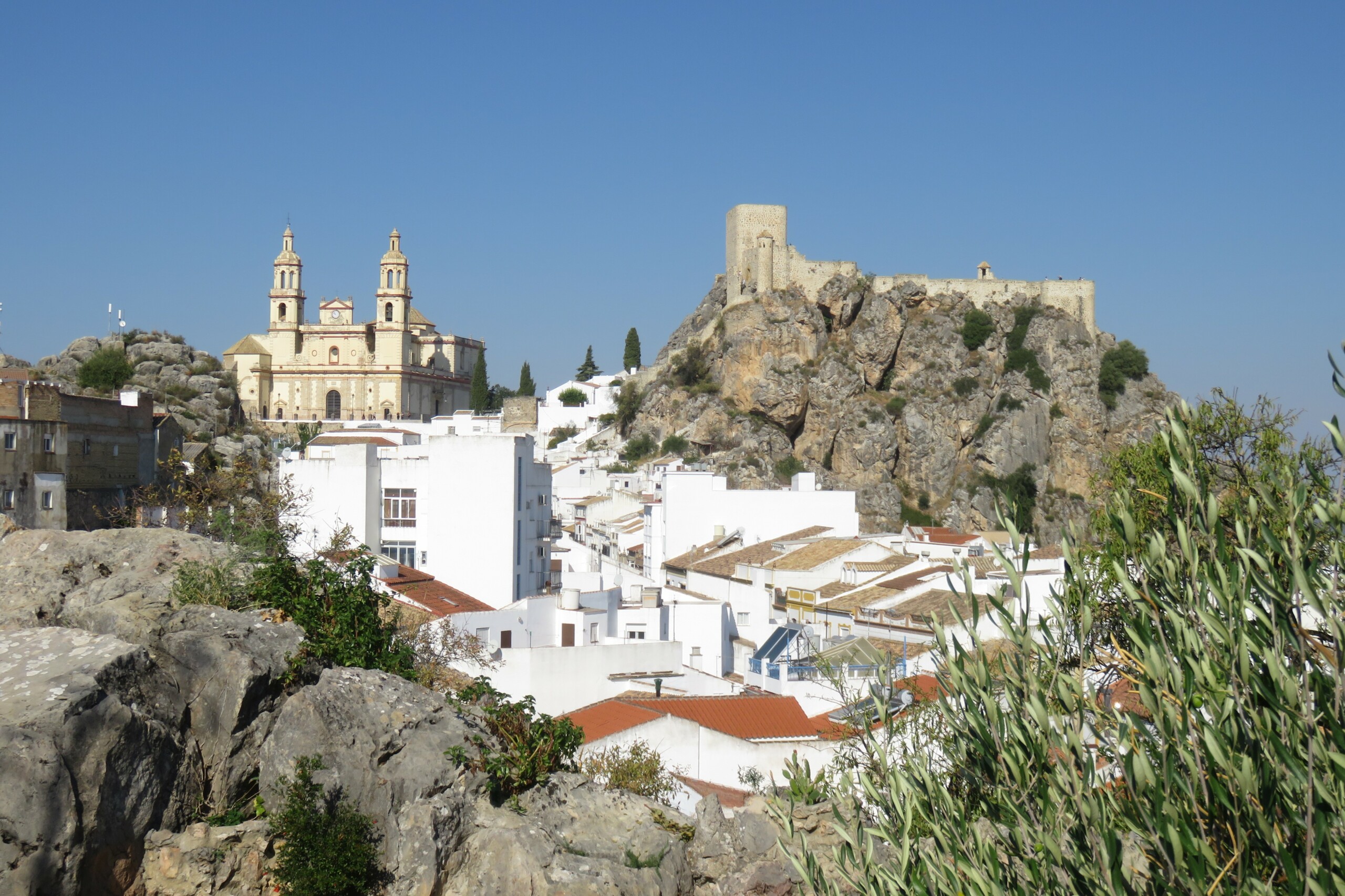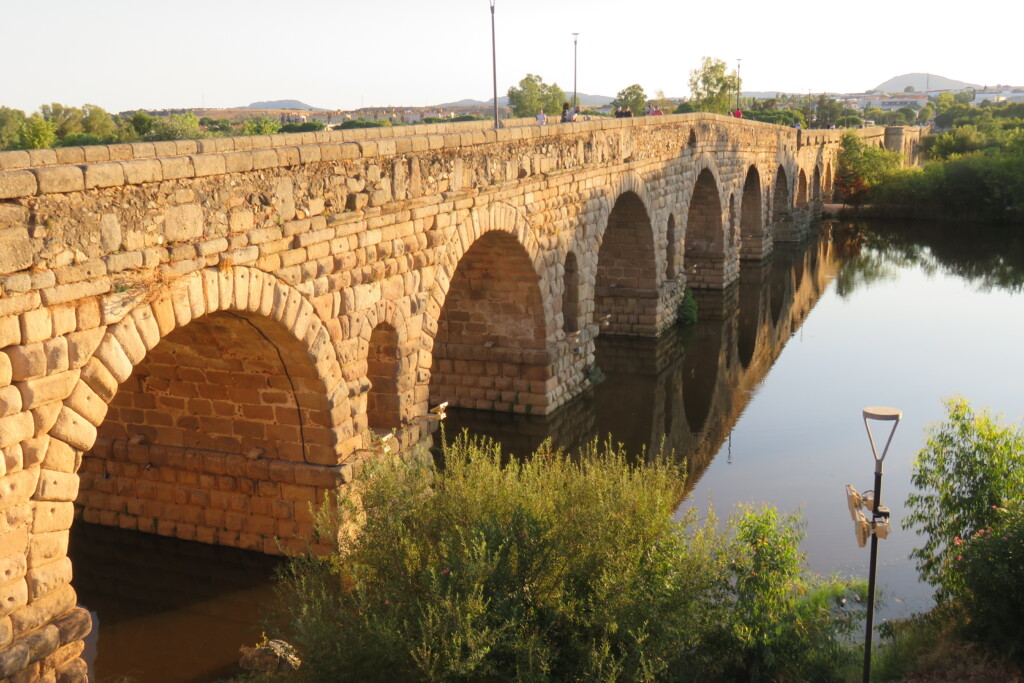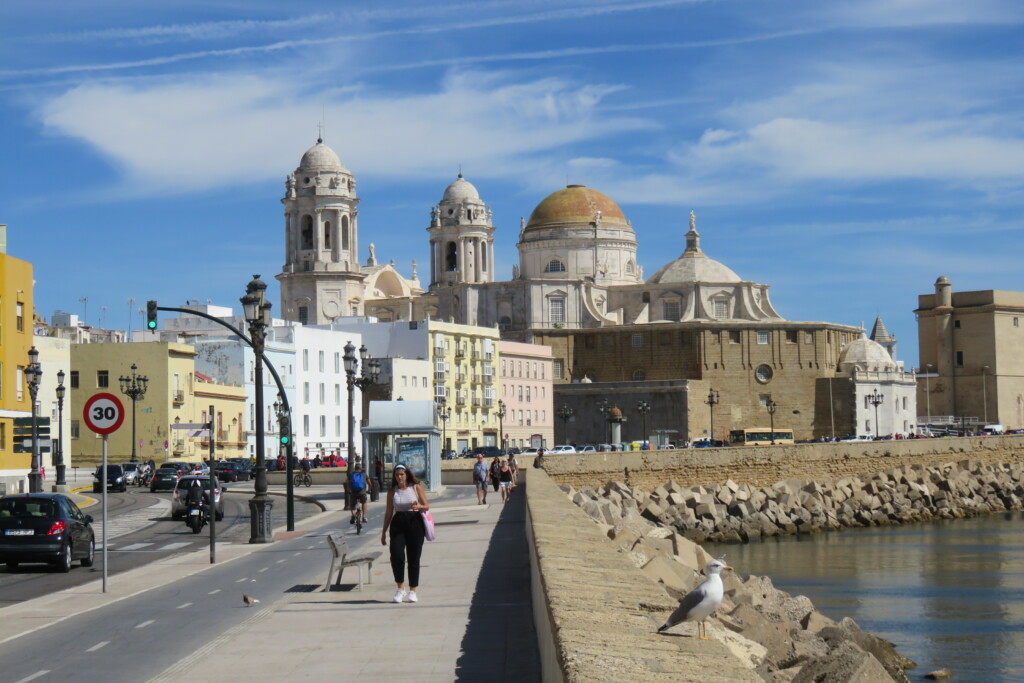España por siempre

Photo by Jerry Cvach
Driving east from Portugal I am nearing the Spanish border, nervous about what awaits me. The closer it is the faster I drive to get it over with. Will I need to prove my vaccinations? Will the flimsy documents I carry be an acceptable proof?
The border is now only seven kilometers away. The gently winding road is scenic but I pay no heed expecting a checkpoint behind every turn. My anxiety is rising as I go through turn after turn and nothing yet. Finally there is a sign in the opposite direction. Looking back over my shoulder I read – Portugal 10 km. I am in Spain, no tests, no fuss, no officials in sight and no barrier across the road!
Crossing the border I entered Extremadura region. Its capital city Merida was originally a major Roman outpost and there is evidence of it in many places around town. Some are ruins, and other edifices are still pretty well intact, most notably the bridge that is the longest one in existence. It must span the wide Guadiana River, plus an island in the middle and marshes on each side. It is half a mile long, has 62 arches and is 2,100 years old.

It was crowded on the warm late summer evening. In the archeological zone within the ancient city boundary lie a forum, colosseum and theatre. Elsewhere in the city stands the Trajan’s Arch, originally the gate to the forum, and on the edge of the town are massive remnants of the now abandoned aqueduct.
Roman building material of choice was sandstone shaped into large blocks and skillfully fitted together.
Their structures were solid and durable. Once they came up with a good design they stayed with it. Their aqueducts, arenas and theaters were built from the same “blueprint” throughout the empire.
Many structures are still used, millenniums later, because they were utilitarian, an infrastructure and public spaces and buildings. If you lavish your resources on temples, your buildings will be torn down every time the religions change.
Merida is not exceptional. Segovia aqueduct still carries water 16 km (10 miles) from the Frío River to the city, also the colosseums and theaters throughout the former empire are still busy putting on shows in many cities around the Mediterranean Sea.
In our times of rapid changes it is comforting to see structures that have endured for thousands of years and will serve thousands of years more.
In the Middle Ages Extremadura was made famous by conquistadors. They were the poor nobles living on even poorer land who had to seek their fortunes elsewhere. They crossed the vast oceans on ridiculously small sailing ships and with just a handful of men.
They were courageous, wild and often cruel men. Two leaders stand out. Hernan Cortes hailed from Medellín just east from Merida who conquered the Aztecs; and Francisco Pizarro born in Trujillo 70 kilometers to the north defeated the Inka. Despite their murky past they are remembered fondly. They started dynasties whose subsequent generations did a lot of good work with their ill acquired wealth.
Directly south lies Andalusia, the storied land of white towns. In the east the coastal mountains rise dramatically from the sea all the way up to the Sierra Nevada peaks over 3,000 meters high. Behind the mountain passes is a gentler, fertile land and the great city of Granada is crowned with perhaps the most magnificent castle ever built, Alhambra.
Beaches of Costa del Sol between Nerja in the east and Gibraltar in the west are the best in Europe. If one wants modern luxuries, perfect weather, sandy beaches, have a drink in an English style pub and to play golf, this is the place to be.
For more Spanish flavor, it is enough to retreat just a few kilometers inland where one doesn’t have to dodge the wayward golf balls.
Andalusia ends at Golfo de Cadiz that is already an Atlantic Ocean. Its most famous ports are Cadiz and Tarifa. On the banks of a river Tinto lies Palos de la Frontera, its once sizeable port is now silted over, but it will always be remembered as the port from which Christopher Columbus sailed for the West Indies in 1492 under the auspices of the royal family.
Other than the high Sierra Nevada, Andalusia is hilly but gentle, dotted with small towns, usually surrounded by endless olive plantations, walnut and almond trees in higher altitudes. It is so interesting because of its history.
After being part of the Roman Empire, it was occupied by Moors from 711 to 1492, when the Los Reyes Católicos, Fernando II de Aragón and Isabel I de Castilla finally dislodged the last Moorish ruler Boabdil and took the Emirate of Granada, the last independent Muslim state in Western Europe.
Boabdil had surrendered Granada without fight. The legend says that when he was leaving he could not contain his tears as he looked back at the magnificent city he had been obliged to leave.
The place is still remembered as El Suspiro del Moro, the Moor’s Sigh. His mother reproached him: “What you weep for like a woman is what you could not defend like a man!”
Come to think of it, 1492 was a very good year for Fernando and Isabel and a big turning point in history!
Boabdil is gone, but the remnants of Arabic architecture, layouts of towns and the ubiquitous Moorish forts crowning every hill, remain.

On vacation 36 years ago, after visiting Alhambra, we headed up to the mountain passes of Sierra Nevada, because we had heard there were remote villages on its southern slopes, an area called Alpujarras. It was late May in southern Spain, within a stone throw from Africa. We had not expected, that the passes would be ten feet under snow, impassable! Business unfinished I finally managed to return.
For centuries Alpujarras were a refuge for the defeated Moors. They were left alone by the new regime under the condition that they would convert to Christianity. For self-preservation they did, although their heart was not in it and became known as Moriscos. Aided by isolation a strong Arab influence is still evident.
The picturesque villages cling to the mountain slopes that are nurtured by irrigation systems dating back to the Boabdil’s time. Houses are piled on top of each other as they hug the terrain. Invariably they have flat roofs with a profusion of chimneys, tall cylindrical things that besides serving their purpose are also useful for stringing clothes lines between them. Looking from a distance, squinting and with a great deal of imagination the villages look like patches of snow on the green brown slopes.
Steeped in history and blessed with good weather Alpujarras were destined to become a tourist attraction. To be really able to explore it thoroughly, having a car is essential. Tourists that come by tour buses don’t venture too far from them, usually just to have a meal and shop for souvenirs. Besides, buses visit only the villages where they can turn around.
The first town off the main highway between the sea and Granada is Lanjaron, a spa. It is a sleepy, slowmoving town like its patients. From there it is up, up and away through villages Carataunas, Soportujar and Pampaneira, threaded on a narrow winding road like beads on a string until one reaches Capiteira, where the pavement ends.
Above lies the Sierra Nevada National Park. There is no habitation above, other than an occasional abandoned shepherd’s hut, poor grazing fields and further up is a forest, that gives way to weather beaten mountain ridges of the Sierra Nevada. From the last parking lots at the end of bad gravel roads it is the hikers’ paradise better suited to men and women half my age. The highway that in 1985 still lead over the mountains and was the highest road in Europe, is now closed to general public.
Only the town of Treverez is not just a tourist Mecca but it has an industry that sustains it. Its special climate is suitable to curing the Serrano Ham. This is a town stuffed with hams like a Christmas turkey! There are many brands of the Serrano Ham in Spain, but the label of being finished in Treverez is the all-important proof of excellence.
Along the highway N323, on the way down to the coast, there is a short stretch of narrow valley with vertical rock walls hundreds of feet high on both sides. It is called Canyon de Guadalfeo.
I stopped on the side of the road to take pictures and noticed a horizontal line on the rock face about 100 feet above the highway. It turned out to be a concrete top of an aqueduct continuing uninterrupted as far as I could see.
It made a comfortable pathway marred only by rocks here and there that had fallen from high above. It was a solitary, quiet place, except for the lizards, and an occasional car hum on the highway below. Suddenly someone unseen talked to me, the hollow sounding words bouncing of the rock walls on all sides. It was a biblical like experience, quite eerie.
Looking around and then up I finally spotted the source, the man with hands white from chalk and wearing soft climbing shoes. He seemed agitated and I could see why!
He dangled at the end of a rope and bounced off the rock wall like a pinball. But he wasn’t the one in distress, he was concerned that I do not lift one of the rocks lying on the concrete, fall through the hole it covered, and be swept away by the current inside.
Warning delivered and duly noted, he continued his upward journey to meet his maker, until he disappeared above an overhanging rock.
In early 17th century Miguel Cervantes wrote his masterpiece Don Quixote de La Mancha. The book is considered the beginning of modern literature and was a compulsory reading when I was young. Episode of Don Quixote fighting the windmills in delusion that they were unfriendly giants is suddenly becoming relevant.
In Spain there are many places where the wind blows incessantly even outside of La Mancha.
Batteries of monstrous windmills are located on the top of the mountain ridges and one wishes for an army of Don Quixotes to fight them. There are mountain slopes where the highway runs on level with the blades rotating in your face.
These blades are giant indeed, possibly 60 or even 80 feet long each. They emit steady hum as they turn. Some are so old that they are starting to show wear and tear. If it was difficult and expensive to build these things, it will be even more so when they will have to be replaced.
Andalusia is considered to be picturesque because of all the Moorish castles’ ruins. Are we also going to let the modern windmills rot after they will be past their prime for the enjoyment of the future tourists?
The security guard/ticket controller by the entry gate to the Caminito del Rey shooed me away from the waiting groups to be let in, and the poor souls that did not have tickets, lest I infect them with the rot of knowing how to beat the system.
It is a very popular hike and one needs to order tickets months ahead, but I managed to talk my way into getting a spot.
I had heard about the wonders of this extraordinary five-kilometer hike through tight gorge located not that far north of Malaga. It is a truly hair-raising path seemingly hanging off the side of vertical rock walls like a string of swallows’ nests.
20 years ago it was not just a bizarre hiking trail, it was in a deplorable shape and a death trap.
Using it was a sheer lunacy. There were numerous places where part of, or whole sections had collapsed and large open-air gaps were connected only by narrow steel beams. After two fatal accidents in 1999 and 2000, the local government closed it at both ends.
It is now reopened after it was fixed at a cost of nine million Euros.
The trail was originally built to provide workers at the hydroelectric power plants at Chorro and Gaitanejo Falls with a means to cross between them.
The original path was constructed of concrete and rested on steel rails supported by stanchions built at approximately 45 degrees into the rock face.
The walkway was two to three feet wide and rose over 100 meters above the river.
The construction of the power plants began in 1901 and was finished in 1905.
King Alfonso XIII crossed the walkway in 1921 for the inauguration of the upper dam, and it became known by its present name. They don’t make kings like that anymore!
For Andalusians hope for rain springs eternal. To them the word “rio”, or a river, is a very wide concept. Some are gullies with river beds completely dry after the summer heat, all the way up to rivers capable of navigation.
People must be hoping the dry gullies will become rivers one day, worthy of the designation: “rio”.
This is what is so attractive about this country and its people, and why I keep coming back.
The fervent belief that the nourishing rains will come and prosperity will be here again!
